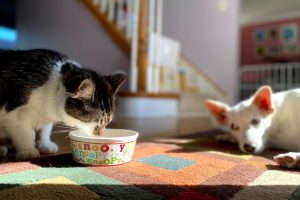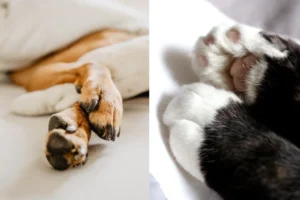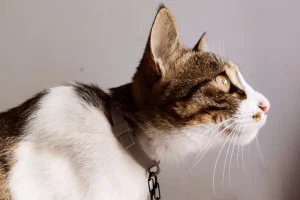Cats’ rough tongues are a fascinating part of their anatomy, often leaving owners curious about the reasons behind this unique trait.
Have you ever wondered why cats have such rough tongues? Let’s explore the reasons behind this interesting feature of our feline friends.
Biology of a Cat’s Tongue
Have you ever felt your cat’s tongue and wondered why it feels like sandpaper? Well, that rough texture is due to thousands of tiny backward-facing spines called papillae covering the surface of their tongue. These papillae are made of keratin, the same material that makes up our fingernails. This unique adaptation helps cats with various tasks, such as grooming and eating.
The rough texture of a cat’s tongue serves as a built-in comb to help keep their fur clean and free of tangles. When a cat licks themselves, the papillae work to remove dirt, debris, and loose fur from their coat. Additionally, the abrasive surface of their tongue helps to stimulate oil glands in their skin, which can help with waterproofing and conditioning their fur.
Interestingly, a cat’s tongue also plays a vital role in their eating habits. The rough texture aids in stripping meat from bones and lapping up water efficiently. It helps them grip and pull meat apart, making it easier for them to consume their prey.
Overall, the biology of a cat’s tongue is truly fascinating and showcases how these unique animals have evolved specific adaptations to meet their grooming and feeding needs.
Cleaning and Grooming
While cats are known for being clean animals, their rough tongues play a significant role in maintaining their hygiene. When a cat grooms itself, the texture of their tongue acts like a natural brush, helping to remove dirt, loose fur, and parasites from their coat. This self-cleaning mechanism not only keeps them looking neat but also helps to regulate their body temperature.
Aside from grooming their fur, a cat’s rough tongue is also used to lick wounds as a form of cleaning and promoting healing. The rough surface of their tongue may help remove debris or dead tissue from a wound, serving as a primitive but effective way of caring for themselves.
Moreover, the rough texture of a cat’s tongue aids in stimulating blood flow and circulation when they groom themselves. This process helps distribute natural oils produced by their skin, keeping their coat healthy and shiny.
In addition to grooming, licking themselves also has a calming effect on cats, helping them to relax and reduce stress. So, next time you see your feline friend grooming with their rough tongue, know that it’s not just about cleanliness but also about relaxation and self-care.
Taste and Texture Sensitivity
Have you ever wondered why your cat’s tongue feels like sandpaper? Well, the rough texture of a cat’s tongue isn’t just for show – it’s actually a superpower that enhances their sense of taste and texture when eating. This unique feature allows cats to better grip and tear apart their food, helping them enjoy every bite.
When a cat eats, their tongue acts like a mini scrub brush, helping to remove every last bit of meat off the bone or clean their fur meticulously. The tiny barbs on their tongue also help to stimulate taste buds, making their dining experience even more flavorful. So next time you see your kitty grooming themselves or chowing down on a meal, remember that their rough tongue is a key player in their taste and texture sensitivity.
And hey, if you ever need some extra motivation to clean your plate, just remember that your cat’s rough tongue is cheering you on from afar!
Drinking Behavior
Did you know that a cat’s rough tongue plays a role in their drinking behavior as well? Unlike other animals who use their lips to create suction, cats lap up water in a totally different way. When a cat drinks, they delicately touch the tip of their tongue to the water’s surface and pull it back quickly, creating a column of liquid to swallow.
The rough texture of a cat’s tongue actually helps to lap up water more efficiently. Those tiny barbs act like little hooks, trapping liquid and allowing cats to drink with precision. So next time you catch your feline friend taking a sip, remember that their unique drinking behavior is all thanks to that rough, sandpaper-like tongue.
And here’s a bonus tip for cat owners: always make sure your furry friend has access to fresh, clean water to encourage healthy hydration habits. Your cat’s tongue will thank you!
Communication and Bonding
Cats have a rough tongue for more than just grooming themselves. Their sandpaper-like tongue plays a vital role in communication with other cats and humans. When cats lick each other, the rough texture of their tongue helps remove dirt, debris, and loose fur. This grooming behavior not only keeps their coat clean but also strengthens social bonds among feline friends. As a cat owner, when your furry companion gives you a gentle lick, it’s their way of showing affection and trust. So next time you feel that rough tongue on your skin, know that it’s a sign of love and bonding from your feline friend.
Medical Implications
The rough texture of a cat’s tongue serves a practical purpose beyond grooming. Believe it or not, it acts like a natural comb, helping to keep their fur clean, smooth, and free of tangles. This grooming mechanism is essential for cats in maintaining their coat health and regulating body temperature. Additionally, the abrasive texture of their tongue aids in removing loose fur, reducing the chances of matting and hairballs. However, it’s crucial to monitor your cat’s grooming habits, as excessive grooming or changes in the texture of the tongue could indicate underlying health issues that require veterinary attention.
- Dental Health: Apart from grooming, a cat’s rough tongue also benefits their dental hygiene. The rough surface helps remove plaque and food particles from their teeth, acting as a natural toothbrush. Encouraging regular grooming and dental care practices can promote oral health in your feline companion.
Evolutionary Advantage
Cats have a rough tongue that feels like sandpaper because of tiny, backwards-facing barbs called papillae. These papillae help cats groom themselves more efficiently by acting like a comb to remove dirt, debris, and loose fur from their coat. This unique feature not only keeps cats clean but also helps regulate their body temperature by removing excess fur during grooming.
The rough texture of a cat’s tongue also serves a protective purpose. When a cat licks a wound, the rough surface helps to clean the area and stimulate blood flow, promoting faster healing. In the wild, this self-cleaning mechanism is crucial for survival as it reduces the risk of infection in open wounds.
Interestingly, the rough texture of a cat’s tongue can also be attributed to its diet. In the wild, cats often consume prey with tough skin or feathers, and the rough papillae on their tongues aid in gripping and tearing their food.
Fun Facts About Cat Tongues
- Unique Cleaning Technique: Cats spend about half of their waking hours grooming themselves, thanks to their rough tongues.
- Taste Buds: Cats have fewer taste buds on their tongues compared to humans, which may explain their picky eating habits.
- Sensitivity: A cat’s tongue is highly sensitive due to the numerous nerve endings present, making it a vital tool for exploration and interaction.
- Thirst Quencher: Cats use their tongues to drink water by quickly lapping it up, thanks to the tiny hooks on their papillae that help draw liquid upwards.
- Cooling Mechanism: When a cat pants, it uses its tongue as a cooling mechanism by evaporating moisture from the tongue’s surface.
Next time you feel the unique texture of your cat’s tongue during a gentle grooming session, remember the fascinating evolutionary advantages and fun facts that make them such remarkable creatures.
Alex, a passionate animal lover, has experience in training and understanding animal behavior. As a proud pet parent to two dogs and three cats, he founded AnimalReport.net to share insights from animal experts and expand his knowledge of the animal kingdom.









